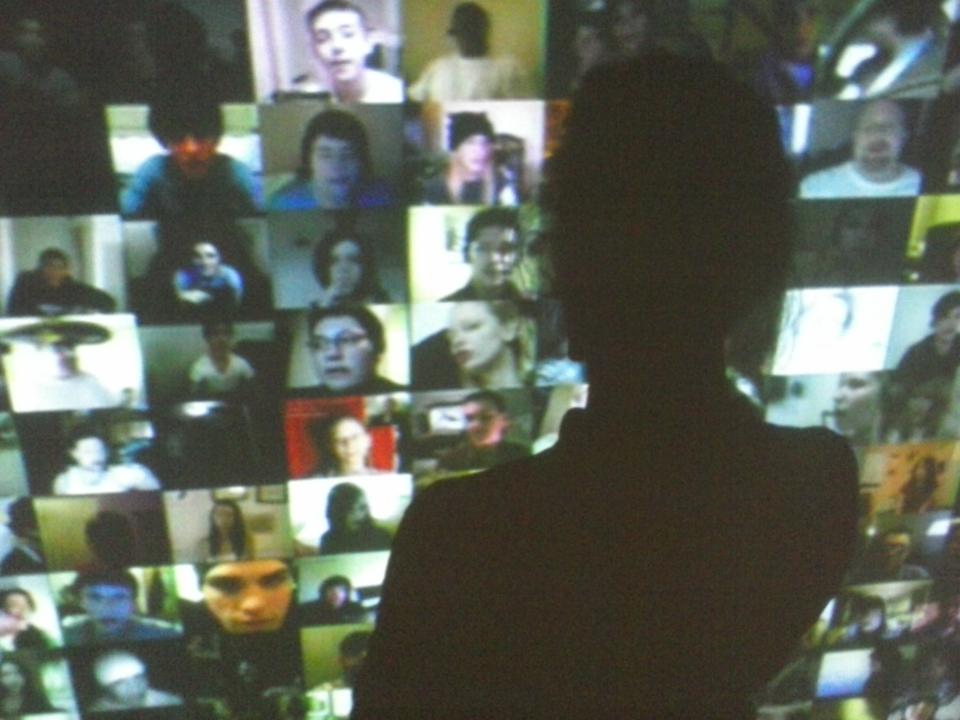
‘What is a modern subject in a world without mirrors, a world where the gaze is tightly controlled and you are always the object of that gaze?’ – Jenna Brager
When we think about digital surveillance, there’s no dearth of available examples. From the 2013 exposure of the NSA’s email surveillance that led to the wildly popular Tumblr ‘Obama’s Checking Your Emails’ to the fact that pretty much wherever we go there’s a CCTV camera following us (and we’re never sure who owns that footage and what they can do with it), surveillance is on the rise. Being continuously watched by unknown eyes is almost accepted as the modus operandi of an increasingly digitised world.
Correspondingly, surveillance is a hot topic in several forums, from tech conferences to top-level government meetings. But what often gets left out of discussions is this: surveillance has, historically, socially and politically, always been an issue of gender. This isn’t a phenomenon unique to the technologies of today, because living under constant surveillance is enmeshed in the experience of being a woman – and has been way before CCTV became a thing. And much of what we experience as digital surveillance today is still rooted in gender inequalities.
From the dude opposite you in the underground who definitely seems like he’s taking a picture, not searching for signal (uh, we’re under the ground) to the CCTV your building installed that now shows you drunkenly stumbling home late at night, the surveillance camera – hidden or otherwise – is everywhere.
And more often than not, those determining the angle of the camera tend to be men.
…
In December 2012, a small district in India called Puri designed an initiative to keep women safe on its main beach, The installation of two CCTV cameras, so that law enforcement could keep an eye out for potential harassment. The project cost 9 lakh rupees (around USD14,700) but was determined by the local governing body to be worth its while. However, in less that a week the cameras had to be removed after protests by women in the area, who simply refused to use the beach while they were up. Why? Because for them to feel comfortable swimming in the sea, their bodies at least partially on display, the last thing they needed was a recording camera.
Proponents of mass surveillance often ask the question, ‘If you have nothing to hide, why are you worried?’ Leaving aside the dangers of mass data collection, racial profiling, and treating everyone like a criminal-until-proven-innocent, this question has a bunch of different implications for women. The constant and rigorous emphasis placed on the female body in societies across the world tells us two things: One, our bodies are something that we should hide, and paradoxically two, our bodies are something that are constantly on display. The presence of surveillance cameras in pubic or private spaces – hidden or otherwise – encapsulates this dichotomy perfectly. You have nothing to hide except your body, which is of course impossible, because no matter how many clothes you put on, it’s still there. When it comes to spaces that tend to be male-dominated, your crime is the presence of your body, and the camera is, by extension, justified in capturing what you are ‘supposed to hide’.
From ads to art to simply the experience of walking down the street or swimming in the ocean, it’s no news to any woman that her body is constantly being watched. And for women who come into contact with digital technology (either by having access to it themselves or being watched by those who do have access), digital surveillance is a continuation of this constant gaze and tends to happen in ways that are rarely counted when it comes to the ‘big’ issues of privacy in the digital era.
From installing hidden cameras in women’s changing rooms to the violence of ‘upskirting’ – taking photos with mobile phones ‘up’ a woman’s skirt in public places, a violation that is steadily increasing in countries including South Korea and Japan – the hidden camera is potentially everywhere. And with amateur porn websites that more often than not display non-consensually filmed videos, you can’t blame the women of Puri for being more concerned about footage of their swimwear than the camera’s ability to capture street harassers. And we haven’t even gotten into jealous lovers (ever heard of Mate Watch? It’s the equivalent of Net Nanny, a browser tracking software that allows you to see what your partner is up to online), angry, potentially violent ex-lovers (hello GPS tracking on my phone) and the creepy boss at that old job you had (is this picture really for the ‘staff file’?). In fact, if you Google ‘digital surveillance’, the top results aren’t talking about how this surveillance is exercised, but instead, are websites advertising ‘Digital Surveillance Solutions’: In other words, helping the ‘common man’ to become a surveillance expert.
You know that phrase detective books often use? The one that goes ‘I had the strange feeling someone was watching me’?
I’m positively certain that was first written by a man. Because for women, the experience is far more quotidian than it is strange.
…
Earlier this year, Indian beauty brand Ponds launched a campaign called ‘Are You Selfie Ready?’ as a way to promote Ponds White Beauty BB Cream (here we won’t get into the horror of ‘white beauty’). From slogans that read ‘A selfie a day keeps the insecurities away’ to the user-created ‘Selfie Wall of Fame’, Ponds tells girls and women what Tyra Banks has been saying for over a decade: Every street is a catwalk. But this time around, you are your own photographer, which doesn’t mean you get to be any less vigilant. Watch yourselves girls, because the world is watching you.
And watching we are. In a study that analyses over 140,000 Instagram images from 5 countries across 1 week, findings show that women take way more selfies than men. In Moscow, for example, women are 4 times more likely to take a selfie than a man, making up 82% of the city’s selfies. In Sao Paulo it’s 65.4%, whereas in New York it’s 61.6%. Though the numbers vary, women still come out on top. And if you consider the types of messages we’re receiving, this is hardly surprising.
As early as 1972, sociologist and art critic John Berger published Ways of Seeing, where he explored the idea of surveillance as one that is always already gendered. He writes,
Men look at women. Women watch themselves being looked at… A woman is… almost continually accompanied by her own image of herself. Whilst she is walking across a room or whilst she is weeping at the death of her father, she can scarcely avoid envisaging herself walking or weeping.
Today, with the advent of the internet and especially social media, the ‘envisaging’ of our selves has moved from our own consciousness to a profile page. Social media makes demands on all of us – irrespective of gender – and dictates that we craft an image of ourselves that we want the world to see. But even though almost everyone is striving to be smarter, sexier and having more fun than their 753 Facebook friends, this drive to be a shiny happy person plays itself out differently across genders.
Societies place a high premium on the female body, and the ways in which women present themselves in public is under constant scrutiny. On the internet – a public platform like any other – the way in which we watch and represent ourselves is as demanding as it is on the street.
And if we use Berger’s logic of women watching themselves through male eyes (a notion that has been employed by several strands of feminist theory, most famously through the idea of the ‘male gaze’), then it would follow that when women take a selfie, they’re posing for an imagined male viewer. This doesn’t mean that it’s only men looking at a woman’s pictures, but the idea behind this theory is that the imagined viewer of any representation of a woman is always a man.
Of course, not everyone buys this, because a selfie erases the gap between the photographer and the subject: Here they occupy the same position. Instead of posing for a male lens and framing your body through a male gaze, many believe that the selfie allows you to frame yourself however you want to be seen. From breastfeeding mothers resisting the idea that this is an ‘obscene’ act to women in Turkey posting photographs of themselves laughing after Prime Minister Anric said that honourable women don’t laugh in public, the ways in which women craft images of themselves online are perhaps not as simple as the dictums of the male gaze.
But whether or not the selfie is empowering or simply another indication of women being objectified (or, what’s more likely, an occasional alternation of the two), self-surveillance is a crucial framework through which people, and especially women, are experiencing the digital era.
…
In a shop window on Philadelphia’s Market Street, there’s a visible surveillance camera, a street-facing TV, and a sign that reads ‘Free Self Portraits’. People who stop to investigate will see a recording of themselves appears on the TV screen.
In this public art project, artists Sarah Zimmer and Kim Brickley create composite, layered images of the recordings for the project’s website, which people can then visit to request that their images are taken down – a privilege that rarely exists in real life. But as far as the ‘self’ portraiture of the initiative goes, the lines are pretty blurry. Is it a free selfie because you read the sign, or is it unwanted surveillance because despite reading the sign, you never consented to the recording?
The rise of the selfie and the demand for constant self-surveillance has coincided with the rise of mass public surveillance. As more data is being gathered about us, we are simultaneously giving away tons of it for free. And as the Philadelphia art project demonstrates, it’s getting increasingly hard to draw the line between the photographer, subject and audience of an image. The camera is everywhere, but so is the impetus to capture, record and archive. And for women, this tends to mean an archiving of our bodies: Usually as others see us, and occasionally, as we see ourselves.
So while issues of cyber security, privacy and surveillance form the subjects of heated debates in forums world over, for most women, Big Brother lives a lot closer to home than the NSA. In fact, it’s all the Little Brothers that we’re more concerned about. The neighbour resembling plastic-bag-recording Ricky in American Beauty, who takes surreptitious pictures of you while collecting the day’s post. That picture of me that I posted 7 years ago on MySpace that’s now doing the rounds on some misogynistic Reddit thread. The surveillance cameras set up in schools across America where we’re not quite sure who’s reviewing the content of the girl’s locker room. That nanny cam set up to protect your 6-year-old niece whose footage ends up on a child porn site.
Of course, not every recording camera is out to get you, and not every selfie is a product of the beauty industry. But if surveillance is often a gendered experience based on the fact that women’s bodies are always being watched, it’s high time discussions, policies and laws around the issue started taking our voices into account.
- 22393 views







Add new comment